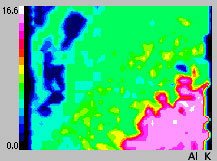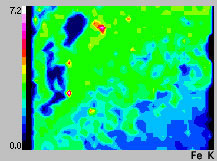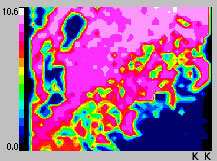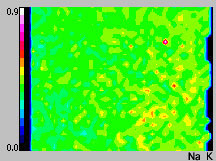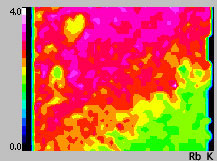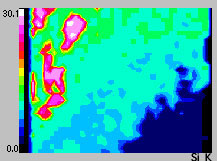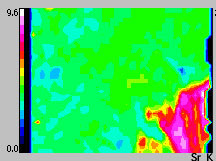| Chemical composition mapping Chemical composition mapping of eight elements, Al, Si, K, Cr, Fe, Ti, Rb and Sr, in the area of 7~7mm is shown in Figure-1. Large difference is recognisable especially in major elements Al, Si and K. Three-dimensional composition mapping of elements Al, Si, K and Cr observed from each direction is shown in Figure-2. Distribution of Al and Cr increase while Si and K decrease toward ruby inclusion from matrix. Rutile inclusions are scattered throughout the samples.
Optical microscope observation These crystal aggregations polished in cabochon or bead are composed of@one matrix of transparent to translucent, grey-green, blue-green and bright green mica and the other of colourless or muscovite and quartz (Photo-3). The former grey-green mica occupies the most part of the samples and it contains more impurities, especially minute brown rutile inclusion. In this swirly grey-green area of mica, circle crystalline part of blue-green to bright green resembling craters seen on the moon is recognised. This is also mica. In the boundary between the grey-green part and blue-green to bright green part, colourless to white mica-quartz matrix lies in a ringed form. Hexagonal tabular or short prismatic ruby crystals developed from basal pinacoids {0001} area also taken into the blue-green part (Photo-4), and several to dozens of them are exposed everywhere on the samples. Lamellar twinning developed from {1011} have also grown. Large crystals of short prismatic rutile inclusion are dispersed in the crater.
Conclusion Our chemical analyses revealed that these crystal aggregates were mainly@composed of grey-green to green, transparent to translucent muscovite (fuchsite) containing high concentration of chromium and colourless transparent to white translucent microcrystalline mica-quartz, some ruby and rutile being mixed. Unfortunately, specific geographical background of this fuchsite containing ruby is unknown at present. Ruby generally occurs in three different metamorphic rocks, crystalline limestone (marble rock) undergone through contact metamorphism, amphibole-anorthite rock and gneiss (Karl, Schmetzer, 2003). Especially from amphibole-anorthite metamorphic rock@distributed in Russia or Greenland, ruby was found and its coexistence with@anorthite, pargasite or mica has been reported (Grygoriev, 2000), however, only a few example of coexistence with fuchsite have been reported, and to the authors' knowledge, no production of this type of ruby in fuchsite from around India that can be used as an ornamental material has been reported so far. References Elisabeth, Strack., 1993. Gemstone Association (ICA) Laboratory Alert No.70. Grygoriev, V.I., 2000 Rubinovoje: Die rotten Korunde von Rai-Iz im Polar-Ural. Lapis,25(9) Karl Schmetzer, Heinz-Jurgen Bernhardt and Edward J. Gubelin., 2003. An anorthite-ruby-pargasite-picotite assemblage. Journal of Gemmology, 28(7). |
||||||||||||||||||||||||||||||||||||||||||||
|
||||||||||||||||||||||||||||||||||||||||||||
